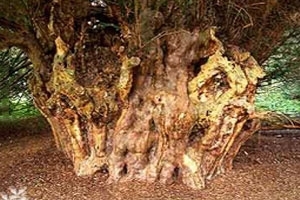Yew tree
 I clearly remember as a child being taken to church every sunday and that during the autumn months, the yew trees which grew in the churchyard gave me the chance to play a great trick on any adult who might be watching.
I clearly remember as a child being taken to church every sunday and that during the autumn months, the yew trees which grew in the churchyard gave me the chance to play a great trick on any adult who might be watching.
Everyone is brought up to believe that all parts of the yew tree are extremely poisonous, which is true, except for the red sticky berry substance surrounding the (also poisonous) seed inside. As the congregation emerged from the service, these “snot gobbles or snottleberries” as children called them, could be eaten (making sure not to swallow the seed) right in front of any adult who was paying attention. The resulting panic that always ensued was hilarious and meant that you were quickly taken home, thereby avoiding the boringly long conversations which tended to take place after church! So why does the Yew have this close association with “Gods Acre” – it can’t just be to frighten adoring parents.
Various popular theories exist, including one that suggests yew trees were planted in the Churchyard so that bows could be made from the wood, thus protecting the community. The churchyard was chosen because it was one of the only properly fenced areas (often using Yew posts as they could even outlive iron posts due to their hardness), meaning that stock could not get in to eat the poisonous branches. Although yew was the wood chosen by archers, they much preferred to source it from abroad, as British yew was considered to be too brittle and contained too many knots, so this theory does not really stack up.
The yew has always been considered to be a protective tree, not only being a powerful deterrent against elves and the spirits of the returning dead, but also by providing shelter to the church from gales and driving rain. This theory does carry some truth I’m sure, but to find the real reason why yew is synonymous with churchyards, I believe you really have to go back before Christianity ever reached these shores.
The Druids regarded the yew as sacred and often planted them next to their temples. Early evangelists regularly chose to preach under the “sacred yew”, both to gain respectability for the new Christian religion, but also to replace the previous “pagan” worship place. This theory is clearly strengthened by the fact that many yews are far older than the churches they stand next to! Much of the tradition about these trees has been passed on over the centuries and has even become part of Christian worship, for instance by the replacement in many areas of the traditional Palm leaves carried on Palm Sunday.
The oldest yew tree in Europe is the Fortingall Yew, which stands in a Perthshire churchyard and is between 3,000 and 5,000 years old. It is possible that it could even be as old as 9000 years old, but Yew wood does not produce growth rings like other trees and is therefore very difficult to age accurately. This tree’s girth measured in at 56 feet in 1769, although it is not as impressive now as parts have rotted away.
These huge old yews were often considered to be a focal point where people could get in touch with the collective wisdom of generations of ancestors, who “had merged” with the spirit of the tree. I’m not sure about that, but to stand under one of these gnarled old giants always makes me think of the thousands of different happenings that have taken place beneath its boughs, some happy and some not, which is always a humbling experience.
Peter Thompson
Advisory

Download Peter Thompson's essential 26-page book, featuring beautiful photography and detailed profiles of Britain's wildlife
Download FREE >